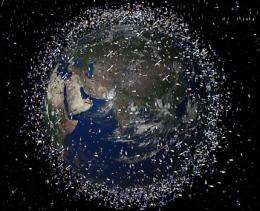March 18, 2011 report
NASA proposes laser use to move space junk

(PhysOrg.com) -- A team of scientists led by NASA space scientist James Mason have proposed the idea of using a mid-powered laser and telescope to nudge pieces of space junk out of the way and slow it down to avoid collisions.
Currently, the low Earth orbit (LEO) is filled with over 9,700 pieces of debris and 1,500 old rocket bodies that are tracked by the U.S. military. When these pieces collide in space, more debris pieces are created. While many of these pieces are small, when you realize that they are traveling at a speed equivalent to 17,000 miles per hour, they pose a serious threat to space travel and the launching of new satellites.
In 1978, a NASA scientist predicted what is now known as the "Kessler syndrome." The idea behind this syndrome being that with the increase in space debris, the increase in collisions, and the generation of more debris could eventually render space exploration and the use of satellites impossible.
Through the years, many proposals have been discussed to remove this space junk, such as rendezvousing with large objects and bringing them back to earth. However, this proposal is complex and comes with a high price tag.
Another study in 1996 suggested using powerful beams to destroy surface material on debris and propel it towards Earth. The concern with this idea is that other countries involved in space exploration could see this as a possible threat to their functional satellites.
Mason and his team at NASA Ames Center and Stanford University have discovered a possible method utilizing much less expensive lasers and providing only enough power to nudge the debris and not cause any damage.
By utilizing a laser beam of five to ten kilowatts, scientists believe that constantly focusing this beam on a piece of debris would exert enough push to change its orbit. The concerns by other countries of this being a threat would be eliminated as this beam would not be capable of creating a force strong enough to alter large functional satellites.
While this would be done on a case by case basis, the question as to whether this would be able to provide a long term solution still needs to be answered. Scientists have said they need to conduct a population model on the debris system to determine if this could be enough of a solution to stop, or at least slow down, the Kessler syndrome.
More information: Orbital Debris-Debris Collision Avoidance, arXiv:1103.1690v1 [physics.space-ph] arxiv.org/abs/1103.1690
© 2010 PhysOrg.com



















